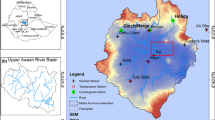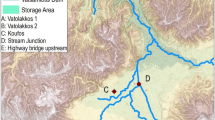Abstract
A primary function of flood inundation mapping is to forecast flood hazards and assess potential losses. However, uncertainties limit the reliability of inundation hazard assessments. Major sources of uncertainty should be taken into consideration by an optimal flood management strategy. This study focuses on the 20 km reach downstream of the Shihmen Reservoir in Taiwan. In the modified dam failure model proposed in this study, the surface area of the water in the reservoir and water elevation are allowed to vary with the volume of the reservoir. A dam failure induced flood herein provides the upstream boundary conditions of flood routing. The two major sources of uncertainty that are considered in the hydraulic model and the flood inundation mapping herein are uncertainties in the dam break model and uncertainty of the roughness coefficient. The perturbance moments method is applied to a dam break model and the hydrosystem model to develop probabilistic flood inundation mapping. Uncertain variables such as roughness coefficient, breach width and reservoir surface area can be considered in these models and the variability of outputs can be quantified. The probabilistic flood inundation mapping for dam break induced floods can be developed with consideration of the variability of output using a hydraulic model. Two different probabilistic flood inundation mappings are discussed and compared. Probabilistic flood inundation mappings are hoped to provide improved insights in support of the evaluation of concerning reservoir flooded areas.











Similar content being viewed by others
References
Baldassarre GD (2012) Floods in a changing climate: inundation modelling. Cambridge University Press, Cambridge
Baldassarre GD, Montanari A (2009) Uncertainty in river discharge observations: a quantitative analysis. Hydrol Earth Syst Sci 13:913–921
Capart H (2013) Analytical solutions for gradual dam breaching and downstream river flooding. Water Resour Res 49:1968–1987
Domeneghetti A, Castellarin A, Brath A (2012) Assessing rating-curve uncertainty and its effects on hydraulic model calibration. Hydrol Earth Syst Sci 16:1191–1202
Domeneghetti A, Vorogushyn S, Castellarin A, Merz B, Brath A (2013) Probabilistic flood hazard mapping: effects of uncertain boundary conditions. Hydrol Earth Syst Sci 17:3127–3140
Foster M, Fell R, Spannagle M (2000) The statistics of embankment dam failures and accidents. Can Geotech J 37:1000–1024
Franceschini S, Marani M, Tsai C, Zambon F (2012a) A perturbance moment point estimate method for uncertainty analysis of the hydrologic response. Adv Water Resour 40:46–53
Franceschini S, Tsai C, Marani M (2012b) Point estimate methods based on taylor series expansion: the perturbance moments method—a more coherent derivation of the second order statistical moment. Appl Math Model 36:5445–5454
Fread DL (1988) DAMBRK (a dam-break flood forecasting model). National Weather Service, NOAA
Froehlich DC (2008) Embankment dam breach parameters and their uncertainties. J Hydraul Eng 134:1708–1721
Henderson V (1966) The nature of nursing: a definition and its implications for practice, research and education. Macmillan, New York
Hong HP (1998) An efficient point estimate method for probabilistic analysis. Reliab Eng Syst Saf 59:261–267
Krause P, Boyle DP, Bäse F (2005) Comparison of different efficiency criteria for hydrological model assessment. Adv Geosci 5(2005):89–97
Li KS (1992) Point-estimate method for calculating statistical moments. J Eng Mech 118:1506–1511
Lin N, Shullman E (2017) Dealing with hurricane surge flooding in a changing environment: part I. Risk assessment considering storm climatology change, sea level rise, and coastal development. Stoch Environ Res Risk Assess 31:2379–2400
Macchione F (2008) Model for predicting floods due to earthen dam breaching. I: formulation and evaluation. J Hydraul Eng 134(2008):1688–1696
Mazzoleni M et al (2014) Innovative probabilistic methodology for evaluating the reliability of discrete levee reaches owing to piping. J Hydrol Eng 20:04014067
Papaioannou G, Vasiliades L, Loukas A, Aronica GT (2017) Probabilistic flood inundation mapping at ungauged streams due to roughness coefficient uncertainty in hydraulic modelling. Adv Geosci 44:23–34
Parhi PK, Sankhua RN, Roy GP (2012) Calibration of channel roughness for Mahanadi River, (India) using HEC-RAS model. J Water Resour Prot 4:847–850
Rosenblueth E (1975) Point estimates for probability moments. Proc Natl Acad Sci USA 72:3812–3814
Sarhadi A, Soltani S, Modarres R (2012) Probabilistic flood inundation mapping of ungauged rivers: linking GIS techniques and frequency analysis. J Hydrol 458–459:68–86
Singh VP, Scarlatos PD (1988) Analysis of gradual earth-dam failure. J Hydraul Eng 114:21–42
Timbadiya PV, Patel PL, Porey PD (2011) Calibration of HEC-RAS model on prediction of flood for lower Tapi River, India. J Water Resour Prot 3:805–811
Tsai CW, Franceschini S (2005) Evaluation of probabilistic point estimate methods in uncertainty analysis for environmental engineering applications. J Environ Eng 131:387–395
Tsai CW, Li M (2014) Uncertainty analysis and risk assessment of DO concentrations in the Buffalo River using the perturbance moments method. J Hydrol Eng 19:04014032
Tsakiris G, Spiliotis M (2013) Dam-breach hydrograph modelling: an innovative semi-analytical approach. Water Resour Manag 27:1751–1762
Vaz de Melo Mendes B, Pericchi L (2009) Assessing conditional extremal risk of flooding in Puerto Rico. Stoch Environ Res Risk Assess 2009(23):399–410
Venkatesh M, Francisco O, Mazdak A, Scott E (2008) Uncertainty in flood inundation mapping: current issues and future directions. J Hydrol Eng 13:608–622
Wahl TL (1998) Prediction of embankment dam breach parameters: a literature review and needs assessment. Water Resources Rsearch Laboratory, DSO-98-004
Wahl TL (2004) Uncertainty of predictions of embankment dam breach parameters. J Hydraul Eng 130:389–397
Wu W (2013) Simplified physically based model of earthen embankment breaching. J Hydraul Eng 139:837–851
Wu S-J, Lien H-C, Chang C-H (2010) Modeling risk analysis for forecasting peak discharge during flooding prevention and warning operation. Stoch Environ Res Risk Assess 2010(24):1175–1191
Xu Y, Zhang LM (2009) Breaching parameters for earth and rockfill dams. J Geotech Geoenviron Eng 135:1957–1970
Acknowledgements
This research is supported by Taiwan Ministry of Science and Technology (MOST) under Grant Contract Number 104-2628-E-002-011-MY3. The authors also appreciate Mr. David D. Kao at National Taiwan University for his kind assistance with the preparation of the revised manuscript, and Mr. Shih-Hsun Huang, and Mr. You-Ren Hsiao at National Taiwan University for their assistance with figures and tables. The data used are listed in the references and tables.
Author information
Authors and Affiliations
Corresponding author
Additional information
Publisher's Note
Springer Nature remains neutral with regard to jurisdictional claims in published maps and institutional affiliations.
Appendix
Appendix
We derive the formula of dam failure.
-
Governing equations
$$\frac{{d\forall_{L} }}{dt} = A_{L} (Z_{L} )\frac{{dZ_{L} }}{dt} = Q_{u} - Q_{B}$$(27)$$\frac{{d\forall_{B} }}{dt} = KQ_{B} S_{D} ,\quad \, \forall_{B} = \lambda_{B} \frac{{b_{B} \delta^{2} }}{{S_{D} }}$$(28)$$Q_{B} (t) = \sqrt {\frac{8}{27}} g^{{\frac{1}{2}}} b_{B} \eta^{{\frac{3}{2}}}$$(29) -
Derivation
-
Step (1)
\(A_{L}\) is constant.
Initial condition: \(Z_{C} (0) = Z_{D} ,\;\delta (0) = 0,\;\eta (0) = 0\)
From Eq. (27)
$$\begin{aligned} & \left\{ \begin{array}{l} Z_{L} (t) = Z_{D} + \eta (t) - \delta (t) \hfill \\ \frac{{dZ_{L} }}{dt} = \frac{{Q_{u} - Q_{B} }}{{A_{L} }} \hfill \\ \end{array} \right. \, \Rightarrow \, \frac{{d(Z_{D} + \eta (t))}}{dt} = \frac{d\delta (t)}{dt} + \frac{{Q_{u} - Q_{B} }}{{A_{L} }} \\ & \because \frac{{dZ_{D} }}{dt} = 0 \, and \, Q_{u} = 0 \, \therefore \, \frac{d\eta (t)}{dt} = \frac{d\delta (t)}{dt} - \frac{{Q_{B} }}{{A_{L} }} \\ \end{aligned}$$(30) -
Step (2)
From Eq. (28)
$$\begin{aligned} & \left\{ \begin{aligned} \frac{{d\forall_{B} }}{dt} = KQ_{B} S_{D} \hfill \\ \forall_{B} = \lambda_{B} \frac{{b_{B} \delta^{2} }}{{S_{D} }} \hfill \\ \end{aligned} \right. \, \Rightarrow \, \frac{{d\left( {\lambda_{B} \frac{{b_{B} \delta^{2} }}{{S_{D} }}} \right)}}{dt} = KQ_{B} S_{D} \\ & \Rightarrow \, \frac{{d\delta^{2} }}{dt} = \frac{{KQ_{B} S_{D} }}{{\lambda_{B} \frac{{b_{B} }}{{S_{D} }}}} \, \Rightarrow { 2}\delta \frac{d\delta }{dt} = \frac{{KQ_{B} S_{D}^{2} }}{{\lambda_{B} b_{B} }} \, \Rightarrow \, \frac{d\delta }{dt} = \frac{{KS_{D}^{2} }}{{2\lambda_{B} b_{B} }}\frac{{Q_{B} }}{\delta } \\ \end{aligned}$$(31)$$\frac{d\delta }{dt} = \frac{{KS_{D}^{2} }}{{2\lambda_{B} b_{B} }}\frac{{\sqrt {\frac{8}{27}} g^{{\frac{1}{2}}} b_{B} \eta^{{\frac{3}{2}}} }}{\delta } = \alpha \frac{{\eta^{{\frac{3}{2}}} }}{\delta }$$(32) -
Step (3)
$$\frac{d\eta (t)}{dt} = \frac{d\delta (t)}{dt} - \frac{{Q_{B} }}{{A_{L} }} = \alpha \frac{{\eta^{{\frac{3}{2}}} }}{\delta } - \frac{{\sqrt {\frac{8}{27}} g^{{\frac{1}{2}}} b_{B} }}{{A_{L} }}\eta^{{\frac{3}{2}}} = \alpha \frac{{\eta^{{\frac{3}{2}}} }}{\delta } - \beta \eta^{{\frac{3}{2}}}$$(33) -
Step (4)
$$\begin{aligned} & \frac{d\eta (t)}{d\delta (t)} = \frac{{\alpha \frac{{\eta^{{\frac{3}{2}}} }}{\delta } - \beta \eta^{{\frac{3}{2}}} }}{{\alpha \frac{{\eta^{{\frac{3}{2}}} }}{\delta }}} = 1 - \frac{\beta }{\alpha }\delta \Rightarrow \eta (t) = \delta - \frac{\beta }{2\alpha }\delta^{2} + C \\ & \because \delta (0) = 0,\;\eta (0) = 0\,\therefore\, C = 0 \\ & \eta (t) = \delta - \frac{\beta }{2\alpha }\delta^{2} \\ \end{aligned}$$(34) -
Step (5)
$$\begin{aligned} \frac{d\delta }{dt} & = \alpha \frac{{\eta^{{\frac{3}{2}}} }}{\delta } = \alpha \frac{{\left( {\delta - \frac{\beta }{2\alpha }\delta^{2} } \right)^{{\frac{3}{2}}} }}{\delta } \\ & \Rightarrow \int {\delta^{{\frac{1}{2}}} \left( {1 - \frac{\beta }{2\alpha }\delta } \right)^{{\frac{3}{2}}} } d\delta = \alpha t + C \\ & \Rightarrow \frac{{2\delta^{{\frac{1}{2}}} }}{{\left( {1 - \frac{\beta }{2\alpha }\delta } \right)^{{\frac{1}{2}}} }} = \alpha t + C \, \because t = 0,\;\delta (0) = 0\therefore C = 0 \\ & \Rightarrow \frac{4\delta }{{\left( {1 - \frac{\beta }{2\alpha }\delta } \right)}} = (\alpha t)^{2} \\ & \Rightarrow \delta (t) = \frac{{\alpha^{2} }}{4}\frac{{t^{2} }}{{1 + \frac{1}{8}\alpha \beta t^{2} }} \\ \end{aligned}$$(35) -
Step (6)
From Eq. (32)
$$\eta (t) = \frac{{\alpha^{2} }}{4}\frac{{t^{2} }}{{\left( {1 + \frac{1}{8}\alpha \beta t^{2} } \right)^{2} }}$$(36) -
Step (7)
$$Q_{B} (t) = \sqrt {\frac{8}{27}} g^{{\frac{1}{2}}} b_{B} \eta^{{\frac{3}{2}}} = \sqrt {\frac{8}{27}} g^{{\frac{1}{2}}} b_{B} \left( {\frac{{\alpha^{2} }}{4}\frac{{t^{2} }}{{\left( {1 + \frac{1}{8}\alpha \beta t^{2} } \right)^{2} }}} \right)^{{\frac{3}{2}}} = \sqrt {\frac{8}{27}} g^{{\frac{1}{2}}} b_{B} \left( {\frac{{\alpha^{3} }}{8}\frac{{t^{3} }}{{\left( {1 + \frac{1}{8}\alpha \beta t^{2} } \right)^{3} }}} \right)$$(37)By application of parallel axis theorem, we derive the first, second, third and fourth moments of the function \(Y\), respectively.
-
-
Variance deviation
$$\begin{aligned} & \int {(x + d)^{2} dm = } \int {x^{2} dm + 2d\int {xdm + d^{2} } } \int {dm} \\ & \because \int {xdm} = 0 \\ & \int {(x + d)^{2} dm = } \int {x^{2} dm + d^{2} } \int {dm} \\ & \Rightarrow E\left[ {d^{2} } \right] = E\left[ {d\mu_{i}^{2} } \right] + P_{i} e_{i}^{2} \\ & \Rightarrow E\left[ {d\mu_{i}^{2} } \right] = E\left[ {d^{2} } \right] - P_{i} e_{i}^{2} \\ \end{aligned}$$ -
Skewness coefficient
$$\begin{aligned} & \int {(x + d)^{3} dm = } \int {x^{3} dm + 3d\int {x^{2} dm + 3d^{2} } } \int {xdm} + d^{3} \int {dm} \\ & \because \int {xdm} = 0 \\ & \int {(x + d)^{3} dm = } \int {x^{3} dm + 3d\int {x^{2} dm} } + d^{3} \int {dm} \\ & \Rightarrow E\left[ {d^{3} } \right] = E\left[ {d\mu_{i}^{3} } \right] + 3e_{i} E\left[ {d\mu_{i}^{2} } \right] + P_{i} e_{i}^{3} \\ & \Rightarrow E\left[ {d\mu_{i}^{3} } \right] = E\left[ {d^{3} } \right] - 3e_{i} E\left[ {d\mu_{i}^{2} } \right] - P_{i} e_{i}^{3} \\ & \gamma = \frac{{E\left[ {(Y - \mu )^{3} } \right]}}{{\left( {E\left[ {(Y - \mu )^{2} } \right]} \right)^{1.5} }} = \frac{{\sum\limits_{1}^{N} {E\left[ {d\mu_{i}^{3} } \right]} }}{{\left( {\sum\limits_{1}^{N} {E\left[ {d\mu_{i}^{2} } \right]} } \right)^{1.5} }} \\ \end{aligned}$$ -
Kurtosis coefficient
$$\begin{aligned} & \int {(x + d)^{4} dm = } \int {x^{4} dm + 4d\int {x^{3} dm + 6d^{2} } } \int {x^{2} dm} + 4d^{3} \int {xdm} + d^{4} \int {dm} \\ & \because \int {xdm} = 0 \\ & \int {(x + d)^{4} dm = } \int {x^{4} dm + 4d\int {x^{3} dm + 6d^{2} } } \int {x^{2} dm} + d^{4} \int {dm} \\ & \Rightarrow E\left[ {d^{4} } \right] = E\left[ {d\mu_{i}^{4} } \right] + 4e_{i} E\left[ {d\mu_{i}^{3} } \right] + 6e_{i}^{2} E\left[ {d\mu_{i}^{2} } \right] + P_{i} e_{i}^{4} \\ & \Rightarrow E\left[ {d\mu_{i}^{4} } \right] = E\left[ {d^{4} } \right] - 4e_{i} E\left[ {d\mu_{i}^{3} } \right] - 6e_{i}^{2} E\left[ {d\mu_{i}^{2} } \right] - P_{i} e_{i}^{4} \\ & \kappa = \frac{{E\left[ {(Y - \mu )^{4} } \right]}}{{\left( {E\left[ {(Y - \mu )^{2} } \right]} \right)^{2} }} = \frac{{\sum\limits_{1}^{N} {E\left[ {d\mu_{i}^{4} } \right]} }}{{\left( {\sum\limits_{1}^{N} {E\left[ {d\mu_{i}^{2} } \right]} } \right)^{2} }} \\ \end{aligned}$$
Rights and permissions
About this article
Cite this article
Tsai, C.W., Yeh, JJ. & Huang, CH. Development of probabilistic inundation mapping for dam failure induced floods. Stoch Environ Res Risk Assess 33, 91–110 (2019). https://doi.org/10.1007/s00477-018-1636-8
Published:
Issue Date:
DOI: https://doi.org/10.1007/s00477-018-1636-8




